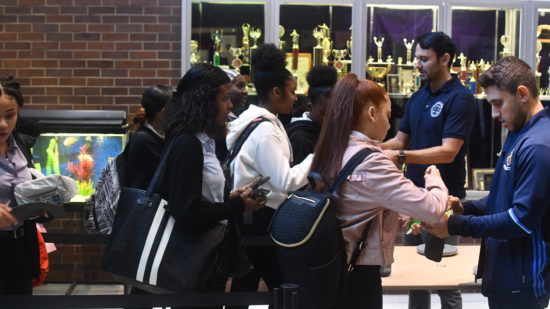
As groggy students trickle into school, administrators at a Melrose school prepare them to say goodbye to their phones.
The Bronx School for Law, Government and Justice, the first school created by the nonprofit Urban Assembly, began using Yondr this fall, a system created to keep spaces phone free. The device consists of a round, gray magnet and padded, lockable pouches for phones. Every morning, students at the South Bronx school file in with pouches in hand, ready for faculty to lock their phones away for the day. At dismissal, students unlock them by tapping the bag against the magnet and pulling the needle-like prong free.
Hundreds of city schools began using Yondr in the fall of 2016. Before Andrew Hara, 37, became a Bronx LGJ Jaguar, he taught at the Bronx Academy of Letters for eight years. After hearing about the phone system by word of mouth, he went back to his old school in May to see how it worked.
“When I observed them, I said, ‘Wow, they’re on to something,’” Hara said.
Bronx Letters had tried a handful of methods to get young people off their phones, before finding a method that seemed to work. Hara learned from those experiences and prepared for push back from Bronx LGJ students who would have found efforts to separate them from their phones radical. After piloting the Yondr system this past summer, Bronx LGJ was ready.
Hara said that in the first month of school, he only saw one student using a phone, as opposed to last fall, when it was dozens.
“A group of students came to me and said they’re able to focus better,” Hara said. “That was music to my ears.”
History teacher Kimberly Felder said Yondr has increased classroom instruction time. There’s no time lost to walking the classroom hunting for phones or convincing students to put them away, she said.
No students have complained to Felder about the new system, but that doesn’t mean every student is happy.
“Kids will try everything, you know,” said Arianne Sosa, the school secretary.
At the beginning of the year, Sosa called every student’s parents to find out if they had a phone, so that the school could assign them Yondr pouches. For students without phones, an identifying sticker was placed on their ID instead. The issue, she said, is that some parents lie so that their child isn’t placed on the list.
Old iPhone models, often with cracked screens, have also found a new purpose as decoy phones, Sosa said. Students put the old one in the pouch, leaving their actual phone free. To counter that maneuver, the school’s administration calls home when they see a suspicious phone, asking parents to confirm what the student’s in-service phone really looks like.
Sixteen-year-old Adriana Alcantaro has made her peace with the new policy.
“At first, I hated it,” she said. “I said, ‘Me? Phone? Pouch? No.”
Now, she admits, it’s not that bad—even for someone who loves Snapchat. During summer school, Alcantaro used to try to pry the pouch open. She looked on Amazon for the magnet to unlock it herself. Now, she can honestly say she appreciates Yondr.
“It’s worth it,” Alcantaro said. “Before I noticed, sometimes teachers would ask something and people would be lost. Now, it’s a step up.”
To quantify how Yondr is impacting their students, the administration will compare grades and the amount of phone-related behavior issues over the course of the school year.
“You’re going to get used to it,” she said. “You’re going to like it.”

